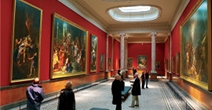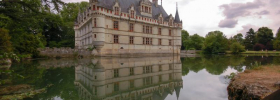 Home
Home- > Tours
- > Midi-Pyrénées
- > Tarn-et-Garonne
- > Lauzerte
- > Lauzerte
Lauzerte
| Topic | Sciences and discovery |
| Departure | LAUZERTE (82) |
| Details | Lauzerte, medieval bastide in the area known as Quercy Blanc and Halt on the Routes of Santiago de Compostela, is One of the Most Beautiful Villages of France. A nature stop for family excursions and weekends exploring the rich past and present of the South West: our heritage and architecture, our leisure activities and festivities. |
Lauzerte, one of the most beautiful Villages of France
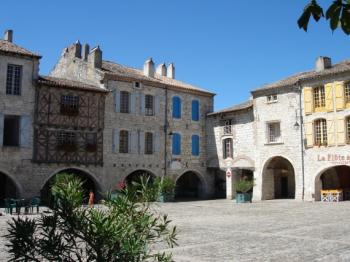
Lauzerte has been listed since April 1990 as one of the “Most Beautiful Villages of France”, villages selected for the quality of their heritage, of their architecture and of their environment. Obtaining this classification involves a rigorous selection process and retaining it requires constant efforts.
Originally, the hill on which Lauzerte is located was a Gaulish oppidum or administrative centre. Its present name dates back to approximately 1000 AD. Derived from the Latin lucerna (lamp), it designates an ideal position, visible - like a light - from a distance.
At the end of the 12th century, the Count of Toulouse was gifted the hill in order to build a castelnau, a city protected by a castle. The foundation of the castelnau, given its strategic and economic advantages, was an instant success. Two hundred building plots were distributed to the first inhabitants, drawn by the freedoms they would earn. By around 1200, Lauzerte stretched along a single road, to the north, while a path circled the plateau to the south. Between the two, the space rapidly filled up and the square was built modelled on that of Montauban. Outlying neighbourhoods were later to complete the urbanisation of the fortified site.
Halting place on the pilgrimage route to Compostela, a thriving market town, populated and wealthy - witness its medieval houses - Lauzerte remains to this day one of the most beautiful and the most typical of the hill top castelnaus to be founded in the south of France.
Located in the heart of the Chasselas table grape appellation (certified area), where Quercy melons are also grown, Lauzerte does indeed look out over a mouth-watering landscape, its pathways meandering between limestone plateaus and gentle valleys. As the seasons unfold, the latter take on the colours of the fruit trees, sunflowers, sweet corn, vines, lavender…
The richness of the minor local heritage, dominated by the dazzling white of the limestone rock (pigeon towers, mills, isolated chapels, prosperous farms, etc.) echoes the charm of the village itself.
In the upper part of the village, a typical example of medieval architecture, houses are arranged around the church of Saint Barthélemy and the square, Place des Cornières, one of the finest in the region. The ramparts are a reminder of the role played by Lauzerte, alternately seized by the English and the French during the Hundred Years War. Early Gothic or Renaissance houses are a reminder that the medieval city was also much prized by rich magistrates and prosperous merchants. They knew full well how to defend the privilege of their quality of life. Today, Lauzerte follows in their footsteps, to the great delight of its many visitors.
Accommodation nearby
Tour of a bastide
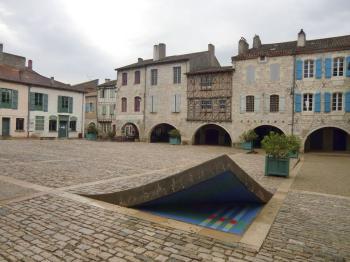
* Place des Cornières
The modestly proportioned square (35 x 30 metres) is laid out where the summit of the hill broadens out, giving the greatest scope for building. Focus of community life in the bastide par excellence: markets, proclamations of consular decisions, and place of entertainment and execution alike. Bordered on three sides by basket handle or three-centred semi-circular arches and houses dating from the 15th to the 18th centuries, the square also boasts the corner house which lends it its name.
* The church of Saint Barthélemy
The church is positioned at an unusual angle, perpendicular to the square. Of the earliest 13th century building, only the first bay and the doorway opening onto the square survive. In the course of various reconstructions and enlargements, the church has been somewhat thrown off balance and the various phases of these works can be clearly identified. Inside, some interesting features: stalls, paintings, a Baroque altar, painted panels attributed to Joseph Ingres and his pupils, and a pipe organ.
* The Barbican
Now that the great periods of strife are over, this defensive military structure, designed to protect the Auriac gateway from assaults launched from the lower part of the village, has given way to a graceful esplanade. Its magnificent views indeed inspired a local poet, Pierre Sourbié (1906-1985), to write a poem entitled La Barbacane.
* The Pilgrim’s Garden
This unusual garden traces the history and the journey of self-discovery of the pilgrimage of Santiago de Compostela. .
The garden takes the form of the Game of the Goose. The players or visitors progress along a path dotted with squares and numbered panels, following stages recounting the daily life of the pilgrim.
Free entry. Open all year. Explanatory notes and dice are available from the Office de Tourisme.
* The medieval houses of the Grand Rue and the Rue de la Gendarmerie
Lauzerte can hardly be said to conform to the classic chessboard layout of a bastide and this can be explained by the nature of the site. Two long streets cling to the contours of the hilltop, linked by narrow transverse alleys. Lined with merchants’ houses built of dressed white stone and dating from the 13th and 14th centuries, these are a visible legacy of the most opulent period of civil construction in the bastide. They recall the prosperous days when Lauzerte acted as a granary for the city of Cahors. The unity of their façades can still be made out beneath more recent transformations: on the ground floor, two pointed arches (the larger reserved for the shop, the smaller giving access to the living area); a mezzanine floor lit by small openings to display merchandise; a first floor serving as a living area and the finest part of the house, opening onto two gemeled windows with carved capitals; and finally an attic floor lit by a single circular window.
* The former Clarisse convent
This ensemble of buildings housed a community of Poor Clare Sisters from the 17th century until the Revolution. It was subsequently the police headquarters, hence the current name of the Rue de la Gendarmerie. Renaissance façade (doorway, mullion windows). Private property.
* Place de la Brêche
This square takes its name from the various occasions on which the defences were breached here (by the English during the Hundred Years War and by protestants during the Wars of Religion) . Ceramic fountain and pyramids by Jacques Buchholtz in the garden below.
* The Carmelite church
At the foot of the village, as you leave the Faubourg d’Auriac. Originally built following the installation of the Order in the 14th century, rebuilt in the 17th century following the Wars of Religion and modified in the 19th century. Baroque altar, pipe organ, pulpit.
* Promenade de l’Eveillé
Built by the Consuls (or bastide administrators) in the 18th century on the site of the former moats, the promenade provided the inhabitants with a place both for strolling and for holding cattle fairs. The outer façades of the houses, set deep into the rock, served as ramparts.
Accommodation nearby
Landscapes in Lauzerte
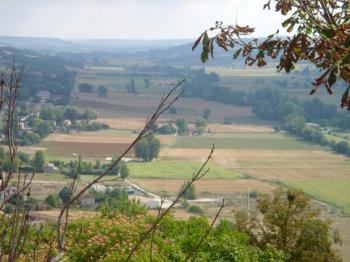
The Tarn-et-Garonne department boasts no less than ten natural micro-regions or terroirs, each with their own character, shaped by their differing natural features, their particular architectural styles and by the intimate relationship between man and his environment, the contours of the land, the climate, and the local produce.
Our region, in the north-west of the department, overlaps two of these geographical and landscape areas aptly named Quercy Blanc, evoking the white limestone and Quercus pubescens or pubescent oak typical of the region, and Pays de Serres, where fertile parallel valleys are separated by long arid crests, or serres.
“You take the high road and I’ll take the low road”
The natural contours of the land consist largely in little hills and valleys defining gently sloping bucolic landscapes, and clay limestone serres, the pale rocky outcrops along the crests.
What runs but never gets tired?
Running parallel to each other from north-east to south-west, the little streams and rivers - Barguelonne, Petite Barguelonne, Lendou, Séoune – finally merge before joining the Garonne river.
A landscape fashioned by man
The Quercy Blanc Pays de Serres area remains highly marked by agriculture, its main economic activity. The influence of the Atlantic and Mediterranean type climate and the diversity of its natural contours giving many different types of soil and exposures, encourage mixed farming and generate a wide variety of crops: cereals, fruit, forage and grazing. Cereal production takes up a large part of the agricultural land. Cattle also play a major part in the economic life of the area, the Blonde d'Aquitaine breed being raised for beef, and the Prim'Holstein for milk production.
The uncultivated north-facing slopes and arid plateaus have been taken over by the pubescent oak (Quercus pubescens) and its undergrowth of box wood, hazelnut trees, juniper etc.
Working the land shapes the landscape, nature is tamed into garden or orchard, dictating the pace and rhythm of the lives of local people and varying their market stall produce.
The area’s micro-climates and mixed farming have preserved areas highly conducive to flora and fauna. The varied and essentially limestone environment encourages the growth of several types of orchids, as well as a large range of wild flowers and plants.
The presence of many insects is characteristic of the local fauna; green lizards can frequently be seen basking in the sun, and magpies, ravens or great spotted woodpeckers are easily startled from their perches. Early to rise walkers may be lucky enough to cross a deer, a hare, a European rabbit or a covey of partridges.
Orchids thrive on clay limestone soils, and more than twenty species can be found locally. Less spectacular than their tropical forest cousins, they nevertheless occur in many colours and are remarkably delicate in appearance. The most widespread are the orchis and the ophrys genera (bee, fly, late spider orchids, etc. which owe their names to their resemblance to the insect in question). The particular and difficult way in which orchids reproduce makes them fragile species, now protected, and in some cases very rare.
Accommodation nearby
Places to visit in Lauzerte

- Lauzerte – the village
Discovering Lauzerte
One of the Most Beautiful Villages of France
Halt on the Routes of Santiago de Compostela
A historical and architectural introduction (on foot) to the medieval part of the village.
- The pilgrim’s garden
Installation designed around a life-size Game of the Goose on the theme of the pilgrimage of Santiago de Compostela: an entertaining way to explore history, the life of a pilgrim in the Middle Ages, and a European cultural and linguistic heritage (pilgrims’ songs).
Listed Remarkable garden (Jardin Remarquable), Midi-Pyrénées region Architecture award 2003, Landscape in heritage (Un Paysage en Heritage) trophy 2003, 1st prize Midi-Pyrénées Cultural tourism trophies 2001.
Free entry. Dice and explanatory notes available from the Office de Tourisme.
- Saint Sernin du Bosc chapel
This attractive Romanesque chapel (11th century, listed Monument Historique) nestles in a little valley aptly named Combe de Miel (honeycomb). Though small, it has some interesting features: a semi-circular apse with radiating vaulting, a triangular gable bell wall, a Romanesque cornice on corbels.
Local charity, set up in 1991 for its restoration, collects donations, handles administrative matters and monitors work on the building.
- Raised pigeon tower
16th or 17th century hexagonal pigeon tower on stone pillars: the main structure consists of 6 panels of timber framing with brick infill; the 6 irregular pillars are of solid stone, capped with a mushroom shaped “hat” (Lo Capel in Occitan) to prevent rodents entering. The roof is topped by a pyramid-shaped “lantern” with wooden slats enabling the pigeons to fly out. At the apex, a ceramic finial representing a pigeon. Free access, please treat with respect as private property
Accommodation nearby
Hike around Chemin of Saint Jacques de Compostelle

Three circuits accessible at the beginning from Lauzerte, Rando-cards available free to the tourist office.
Routes of small excursion in Tarn-et-Garonne around the Way of Saint Jacques de Compostelle. Selection of 24 paths from 5 to 20 km.
Topo-guides on sale with the tourist office. GR. 65, Chemin de Saint Jacques de Compostelle.
Via Podiensis, 1st Cultural Route European, registered with the World heritage of Humanity by UNESCO, is traversed by the GR. 65. Coming from the Puy-en-Velay, it crosses the Tarn-et-Garonne on 53 km. The commune of Holy Juliette marks her entry in the department then it is profiled towards Lauzerte, Moissac and Auvillar, stages cities.
GR. of Country “Quercy Country of Greenhouses”. Circuit of 110 km, alternatives of 75 km. Topo-guides on sale with the tourist office.
Accommodation nearby
Latest news on : Lauzerte
Tourism near
 Visit the city of Lauzerte
Visit the city of Lauzerte - 1 Museum
Tours
 Montaigu-de-Quercy
Montaigu-de-Quercy
 Welcome to Sud Quercy of Lafrançaise
Welcome to Sud Quercy of Lafrançaise






















